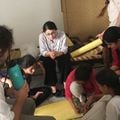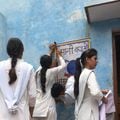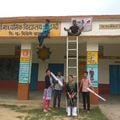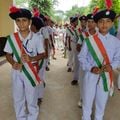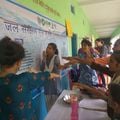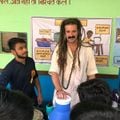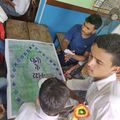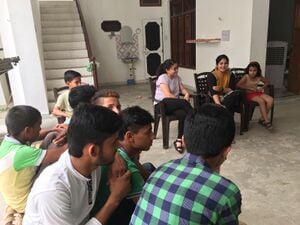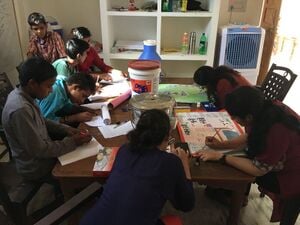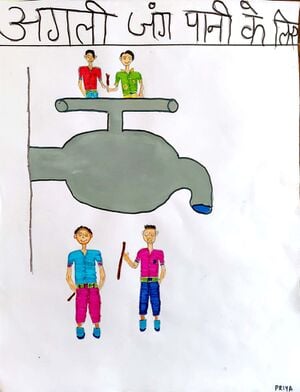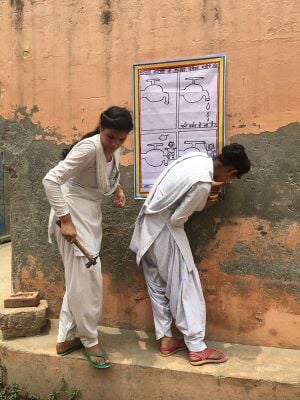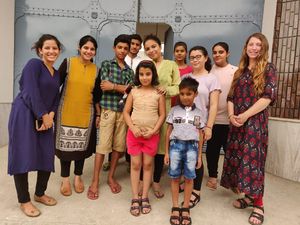
The team in Tavelagarhi comprised of seven students, including three students from Cal Poly Humboldt (HSU) and four from Lady Irwin College (LIC), Delhi University. The students initiated the community assessment which involved identifying needs, resources, and priorities of the community around water and energy. This assessment involved going door-to-door and conducting interviews and focus group discussions with the community members (especially men and women). The community members reported water as a major problem within the village.
Abstract[edit | edit source]
Rural Youth Volunteers in India is a paired/ twinning program between Lady Irwin College (LIC), University of Delhi and Cal Poly Humboldt (HSU), California, which works in collaboration with two local organizations: Environment and Social Research Organization (ESRO) and Grameen evam Pariyavaran Vikas Sansthan (GPVS). The program is supported by the US Mission to India. Both teams are comprised of 8 members, four students from HSU and four students from LIC who are working together for 10 weeks in two rural communities, Daula and Tavelagarhi.
Team members[edit | edit source]
Core Team Members:- The whole team is divided into two subgroups, i.e. Product and the Community/School Engagement teams. The product team includes Aakanksha and Ken whereas the community/school engagement team includes Arshiya, Arushi, Haley, Himani and Kimberly. We also engaged community in the project, there names are Akshay, Hrithik, Jyoti, Riya, Raja, Ashutosh and Hemant.
Community Members:- Netaji Subhash Chandra Bose Inter-College School principal and teachers, students, ASHA workers, ANM workers, Anganwadi workers, leaders and entrepreneurs in Baraut & Tavlegarhi, shopkeepers in the community and religious leaders
Engagement team Background[edit | edit source]
Background of Tavelagarhi[edit | edit source]
'Tavelagarhi is a Village in Baraut Tehsil, Baghpat district and Uttar Pradesh State, India. It belongs to Meerut Division. It is located 42 KM towards North from District head quarters Baghpat. 9 KM from Binauli.' According to Tavelagarhi 2011 census its total population is 4578 and number of houses are 712. Village literacy rate is 56.1% and the female literacy rate is 21.5%. population according to a survey with a diversity of both male, female and children.'[1]
Education[edit | edit source]
There are three schools in the community, two are government driven primary schools and one is community driven higher secondary school. So we use to visit higher secondary school on daily basis and conduct our activities and lesson plans to sensitize them about water conservation, water treatment and water crisis.
Health[edit | edit source]
The village is having Anganwadis centres for providing maternal and child health services but most of them are not working properly. Basically there is no proper health services in the community, so people need to travel a long to get those services.
Program[edit | edit source]
Feel free to link to Rural Youth Volunteers in India for more information.
Sub-team[edit | edit source]
The basic aim of this sub-team was to engage the school and community members on the issues of water conservation. Our approach is to build positive relationships with the community members.The team involved five sub-team members along with eight core team members from the community youth. The core team members were engaged in the community processes with the use of participatory methods that involved learning and creating IEC (Information Education and Communication) materials. Materials like posters, pamphlets, grassroots comics, floor games, puzzles and audio- visual aid like short video which is on the voices of the local community residents on water. We also planned community mobilizing events like education fair and conducted a rally. Apart from this the team also focuses majorly on school engagement and youth participation because of the nature of the community. For that we use various methods to make it more participative and interesting like various lesson plans and activities.
Engagement team also focuses on team spirit and engaging community people in any activity they plan. Community visits, door to door visits as well as going on lunch and snacks party are also a part of the team to build rapport and connections with the people by attending these informal meetings.
The engagement team conducts group discussions for feedback about the product, involvement in prominent events like farmers' class, immunization camp, eye camp, and connecting through ASHA workers. Apart from this the team made regular visits to the Netaji Subhash Chandra Bose Inter-College School to engage students from secondary classes. Several ice breakers, lesson plans and activities were created to address the issues of water conservation, contamination, and water crisis in the classroom setup. The school students were trained to work together in collecting stories around water from the community and creating grassroots comics. Students created posters that portrayed similar issues and were put up at several prominent places within the village and school premises. This involved pictorial representations of water crisis, slogans, and simple solutions that could be worked around water conservation and safety. The students also prepared a street play which involved selecting the issue, writing the script, preparing the characters and conducting the play at multiple locations in the village. Alongside, the team used a few Bollywood songs to recreate the lyrics around water. These songs were then recorded in a professional studio. Overall the community engagement team of tavelagarhi focuses not only spreading awareness and building up skills about the issues but also makes sustainable relations with the community members.
Empathy[edit | edit source]
To understand the community and their perception around the issues of water, the team initiated Transect walks and began interacting with the community members. The initial interactions involved building relationships with the community members through informal home visits and talking about their day-to-day lives. The focal point of the entire exercise was to understand the community perspective and their everyday struggle around water.
Interviews[edit | edit source]
The community interactions and discussions were further elaborated and built in a structured interview format; which was adapted for different stakeholders including the residents (confining to household level)- including both men and women, farmers, ASHA (Accredited Social Health Activist) workers, ANM (Auxiliary Nurse Midwives), school principal, school teachers and students. Several rounds of interviews were conducted with different stakeholders within the community. The team intended to include different sets of people based on their caste, class, gender, and occupation. Some of the people who were interviewed based on their occupation were:
- ASHA Workers: Two ASHA workers were interviewed who described their everyday struggle around water-borne diseases. Since many children did suffer from water-borne diseases, ASHA workers played a vital role in dealing with them, and thus teaching the role of health and hygiene to combat water contamination at household level. Additionally, ASHA workers played an important role in bridging the communication gap between the women of the community and the team. The ASHA workers.
- ANM Worker: The team interacted with her on the immunization day. ANM worker did not share much in regard to water, but her role as ANM and her personal struggle of dealing with women and children was shared.
- School Principal: The principal of Netaji Subhash Chandra Bose Inter-College of Tavelagarhi was interviewed by the team as soon as the school reopened after the summer break. The principal talked about the role of youth in the community to address the issues of water. According to the principal, the youth played an important role in impacting the community actions, because they are educated and the future of this community. If they worked with their families and neighborhood, the change in attitudes and behavior is bound to happen.
- School teachers: School teachers were a little passive than expected by the team. They were ready to support the team for facilitating activities and education fair at the school but did not have much to talk regarding the issue.
- Adults in the community: Approximately 70 adults, including both men and women of different age groups were interviewed about the different sources of water, usage pattern at household level, usage pattern in the fields, storage containers, Hindon River etc. The interview questions were prepared based on the initial interaction and observations.
- School students: The students at school were also included to understand their perspective around the issue of water in the community. It was realized that the students were already aware about many of the issues and the solutions to address these issues. It was realized that the only thing missing is the link between awareness and practice.
These interactions were further built up with brief introductions of the team followed by sharing the background and intent of the project. The discussion was furthered by asking simple questions related to access and storage of water at household level in terms of the various sources and quality of water, the filtration and purification process, and the constraints related to access to safe drinking water. The subsequent responses were recorded and it was observed that the community members had numerable sources to access water for drinking and other purposes.
| Products | Information |
|---|---|
| Submersibles |
|
| Government Water Supply Tank |
|
| Handpumps |
|
In addition to the sources of water, the community members were inquired about the storage containers and how do they filter the water before drinking. Following were the most common responses in this regard:
| System | Information |
|---|---|
| Reverse Osmosis (RO) system |
|
| Earthen Pots |
|
| Plastic Buckets |
|
| Huge plastic containers |
|
-
An interview with the ASHA worker and women in neighborhood
-
Interviewing the village chief
-
Learning about Hindon river
-
Visit to school
Community meetings[edit | edit source]
During the time in the community, we utilized a few community meetings to interact and build rapport with the community members. A few community meetings that were utilized for this purpose were:
- Fire Ceremonies: The team attended a handful of fire ceremonies (called Havan in Hindi) in the initial days. This event was an important time to break the ice and get comfortable in interacting with the community members. The conversations did not necessarily revolve around water, but they did hold importance in terms of introduction and recognition.
- Vaccination Camp: The community organized a vaccination camp which was put on first and third Wednesday of every month. This camp (scheduled on June 20th) was an opportunity for the team to connect with the pregnant women, lactating mothers, and grandmothers of young toddlers. It also helped us get connected to the ASHA workers and ANM worker in the community. The team prepared to conduct a workshop on prenatal and infant development. The objectives of the workshop were introduced with an ice breaking game, followed by a yarn resilience activity. It was a good platform for ASHA and ANM workers to share about their role with the group of women. This was followed by a short film on "Nutrition during pregnancy". The workshop was concluded by sharing a brief about the project and what the team intends to do during the course of time.
- Farmers' School: The team came across a group of male farmers during one of their community visits. An organization had initiated the farmers group to talk about different efficient farming techniques which was named "The Farmers' School." The team grabbed this opportunity to talk about the project with members of the farmer club. They were also informed about the education fair.
- Eye camp: The community school (where the team worked on a regular basis) organized an eye camp with the assistance of an organization from Delhi. This camp was organized on July 15th at the school premises. The team visited the eye camp and interacted with the community members that had come to attend the camp. It was a great opportunity for the team to advertize about the upcoming education fair which was to be put up at the same place.
- Informal community meetings: A few informal group discussions were conducted by the team. The basic aim of this exercise was to understand the perception of community members around safe water storage and generate interest around the same.
-
ANM at vaccination camp
-
Community meeting with members from US Embassy
-
Home visits
-
Informal Community Meetings
-
Sharing learnings with community members
Observations[edit | edit source]
Observation data was collected through participation. This involved getting immersed in the setting of the community members to better understand and empathize with their situations. The process of observation was majorly unstructured i.e. no variables were set to be used for observations. The team tried to not pose biased observations. However, it was frequently noted that the presence of the team members did influence the behavior of the community members. When interviewed, the community members always answered what they thought the team wanted to hear. But, the team observed many things by working with the community.
- Patriarchy: The major observation was the existence of deep-rooted patriarchy in the community. The community was evidently dominated by men, which diminished the participation of women at many levels. The team could talk to women only in their safe spaces i.e. their homes. This further made it difficult for the team to interact with women as they were not able to speak much in front of their male family members. Thus, the team came with the idea of interacting with women at the immunization day.
- Caste System: People belonging to different castes possessed different degrees of power in the community. Thus, the team made considerable efforts to adopt an inclusive approach to include community members, irrespective of their castes.
- Attitudes: The community members appeared stringent at first. But with time, the people became receptive of the information. Gradually, it was observed that community members were curious to know the next steps and would ask what the team was doing.
- Behavior Change: Many students informed how they have adopted the practices of not wasting water by making small changes in their everyday lives. These involved using bucket instead of pipes at home, talking about the issues around water with their family members, closing an unused submersible/tap, and installing an air tight lid and tap to their water containers.
- Sustainability: The team observed a few community members who had the zeal to take this project forward. These members were proposed to be a part of the core team. This core team was formed to sustain the project work that could be continued after the team left.
-
A student proud of his learnings
-
Lack of participation of women
-
Committing to conserve water
Literature Review[edit | edit source]
Community engagement is a very broad term that can have a very different meaning based on different contexts, organizations or industries.There are many terms used under community engagement team these are:
- Public engagement - Public engagement involves the "process that brings people together to address issues of common importance, to solve shared problems, and to bring about positive social change.[2]
- Civic engagement - Civic engagement includes both paid and unpaid forms of political activism, environmentalism, and community and national service. Volunteering, national service, and service-learning are all forms of civic engagement.[3]
- Community outreach -
Community engagement and mobilisation includes[edit | edit source]
- Plan for the long-term
- Identify community priorities
- Map community priorities and identify community leaders through community assessments
- Hold preliminary meetings with community leaders and enlist their support to mobilize community participation
- Hold community meetings to elect local representation to coordinate program activities
- Design projects
- Mobilize resource investments and
- implement community development projects
Definition[edit | edit source]
Problem statement[edit | edit source]
The objective of the program is to asses the needs, and priorities of the community in relation to social and environmental issues and to initiate social entrepreneurship activities in Tavelagarhi while working on environmental issues.
The vision of the program is to see behavioral change in people for social and environmental issues and create social entrepreneurship using the existing resources in the community by engaging all the stakeholders of the community by using different extension methods to combat problems of water wastage and water contamination and encourage safe water storage practices.
Criteria[edit | edit source]
This table includes criteria for both community and school engagement, which was according to its own needs to be addressed. These are the criteria points on which engagement team has worked and core team members will work upon later. Included criteria are the "guiding points" which have helped in creating the guiding map and to record/monitor the path and progress of team.
Community and School Engagement[edit | edit source]
| Criteria | Constraints |
|---|---|
| Behavior Change |
|
| Awareness |
|
| Community Participation |
|
| Communication |
|
| Sustainability/Extension |
|
| Engaging teachers' staff |
|
Ideation[edit | edit source]
- Interviews: In depth interviews with community members and door to door informal visits helped in generating ideas about what work should be done and how should it be done. Interviews initiated the idea generation process and created a link to work on. After interviewing following observations were made:
- realized the needs and priorities of community member
- water conservation was the main issue to be worked upon
- understood the caste dynamics and gender aspects of the community which helped in preparing our activities and plans/visits according to the structure.
- Brainstorming: Brainstorming various times among team members lead to many ideas. pPior to every activity team members brainstormed and worked collaboratively to highlight the importance in what message we would want to convey, such as awareness, water conservation and the product team's "tap system". Brainstorming also took place when determining the different forms of outlets (posters, skit, video etc.) to be portrayed in the community. After Brainstorming following things were finalized for most of the activity:
- All the activities which would be conducted in school would be in Hindi.
- No complex sentences would be formed.
-
Students working on prototypes for comics
- Prototyping: "everything is a prototype". Before finalizing any activity/tool, it went through a lot of discussion among team members and with every discussion, layout of prototype was improved.
- Desk Research/Secondary data Research: Secondary data research for various activities helped a lot in ideation process. Team "tree huggers" did an online course on "Household water treatment and storage". This course helped in building ideas for product team a lot and gave content to engagement team to use in other activities. Secondary data research was also done to finalize lesson plans which was used as ice breaking activities in school engagement and these lesson plans would be given to faculty of school so that they could use these to teach students about environmental issues.
- Personal Assignments: Prior to initial beginning of community engagement whole completed personal assignment that pertained to "properties of elements" & effects of some elements and processes on environment". Team members also did personal reflections on a daily basis in which team facts and personal facts were covered. In personal facts, members had to cover 3 things that they learnt that day, 2 things that they would like to apply in their lives and 1 thing they would like to learn more about. This personal reflection helped in keeping a record and led to generation of ideas for coming days based on prior experience and facts.
Prototyping[edit | edit source]
The function of these prototypes were for them to serve as an outlet to spread awareness, advocate positive behavior change, encourage participation in our mission for water conservation and to promote safe water storage and the product teams tap system. These prototypes were meant to increase knowledge about the water crisis and highlight the possibilities of alternative water uses that will encourage behavior change.
Comics[edit | edit source]
The prototype for these comics began in Netaji, where students were asked to draw up a comic based on ways to save water, how water is wasted, how to practice safe water storage, the benefits of implementing the tap system and some of the student's mother's story of them dealing with water in their household.
-
Students working on prototypes for comics
-
A comic about contaminated water
-
A comic about ways to save water
-
Comics made by students being displayed that portray how water is used commonly wasted
The results of this prototype came to provide a motive to start a compilation of these students stories that will be made into a book for their school library.
Posters[edit | edit source]
In this section of prototyping, we aimed to use the posters as a a visual representation of the product teams efforts in promoting the need for the tap system in order to practice safe water storage, understand how water can be easily contaminated when using the cup method of collecting water and how germs are present on hands and can be transferred into water. Other posters that were created emphasized the importance of water conservation and reducing water wastage. The questions we were hoping to answer were what the need for a safe water storage system is of importance and what was the focus of our project, spreading awareness.
-
Brainstorming ideas for posters to be created
-
Prototype of poster about water conservation
-
Final poster of water conservation being displayed
-
Prototype of a poster that promotes the tap
-
Posters being displayed in the community
-
Protoype of a poster that showed germs and water contamination
-
Final poster displayed in community
-
Posters being displayed in a local primary school
The results of these prototypes were positive in the way that they generated community interest and engagement, provide the community with an idea of the purpose of this project, displayed the effects of water contamination, water conservation and the tap system.
Skit[edit | edit source]
The purpose of this skit was to show how not conserving water can become an even bigger issue and harsh reality that will affect Indian traditions, relations and priorities. The skit portrayed the differences between the present time, 2018, and the year 2030. In the year 2018, a person is using water in a wasteful manner that results in a girl telling the individual that water is being wasted from that action, the girl is then scolded and told she knows nothing for saying that the water should be saved. Fast forward to the year 2030, a young man is looking for a partner but because he is from a village that is suffering from water scarcity, no one wants to marry him. In the skit, the differences you would see in current Indian traditions are noticed when they do not offer or serve guests water or use it very scarcely. The moral of the skit is to convey the message that if you do not take precautions, work together or think about the consequences of water wastage, conditions will worsen and impact society as a whole. The skit also included songs that were derived from local, popular Bollywood movies but the lyrics were changed.
-
Brainstorming ideas for the skit
-
Skit being practiced during rally
-
Final skit being performed during education fair
After many practices of the skit, the enjoyable performance proved to be entertaining, funny and a good message of the importance of water conservation.
Activites[edit | edit source]
The purpose of these activities was to have children be interested in learning about water conservation, safe water storage and other water facts. The prototype of the puzzle was intended to show various ways to save water around the house, in the terms of the local knowledge and community resemblance. The Hindi writing hints to turn off the tap when not using a sink or tap, to use buckets when cleaning their animals instead of a hose and to practice rain water catchment. The puzzle, once drawn up, was cut into squares to make it age-appropriate for most of the audience, the puzzle will be tested at the education fair. The next game, "Water Saver", was intended to be easy and quick to play, as well as fun and educational. The game has water droplet shapes in eight tiles, each being representative of a card that would then be picked up and answered to a question about water conservation. "Water City" is another game based on the local popular game "Snakes and Ladders" that mainly focuses on water facts. In this game the objective is to be the first to reach the 100 mark while trying to avoid the water slides, which will bring you down on a number of tiles, and land on boats to move up. There is 20 water droplet shapes on various squares that are linked to a card with a fact of water conservation, safe water storage or about facts about water in India (i.e.the percentage of water that is drinkable). The prototyping for models was conducted at the school where children were encouraged to work in a direction towards water harvesting, present water conditions or preventing water wastage.
-
Prototype of the puzzle
-
Prototype of a game that focuses on asking players how to save water around the home or in other social settings
-
Prototype of a game that is based on "Snakes and Ladders", which includes players learning facts about water, water conservation and safe water storage.
-
Brief description of prototype step
The results of the prototypes were proven to be successful due to their high interest with each activity.
Tests[edit | edit source]
The culmination of events that took place in the community were the rally and education fair. Both events were intended to either notify the community about the upcoming education fair, perform an informative skit about the possible future without water, advocate the product teams efforts in safe water storage awareness and to educate both adults and children.
Rally[edit | edit source]
The rally was intended to practice and perform the skit, as well as notify the community of the upcoming education fair. We also took this opportunity to display the focus of safe water storage and promoting the tap system.
-
Rally in the community
-
Rally gathering
-
Netaji School participation in rally
Education Fair[edit | edit source]
The education fair was a final team product that was made to educate the community on water safety, water conservation, safe water storage and the importance of the tap system. During the fair, we aimed to engage children through educational games in a games and activities booth that was water-based, as well as other community members through other various booths. The education fair included a booth of models, made by the students of Netaji, that displayed the present condition of the rivers with pollution, rainwater harvesting, and water conservation. A pledge booth was also there to represent each community members commitment to not waste water, always conserve by turning off the tap and other practices, as well as share this knowledge with others. This booth included having them sign the pledge banner, which would in turn give those who signed the banner a bracelet with a water drop to represent the pledge they had taken. Another booth that was in the fair was the safe storage/product booth, where the products of safe storage that featured the tap system were featured, along with a game that highlighted the importance of having closed containers to store water to prevent contamination. Another booth that was featured in the fair was a video booth; this booth included a compilation of videos that was of feedback from local community member's personal experiences with water.
-
Models by students (Netaji Subhash Chandra Bose Inter-College)
-
Pledge booth
-
Safe Storage Booth
-
Water City game being tested and played
-
Water Saver game tested and played during education fair
-
Puzzle
Timeline[edit | edit source]
Introduce the timeline and include a table of the timeline. Briefly describe what you did each day. Alternatively, this could be a link to a google spreadsheet as long as it is one that will not go away (i.e. it should probably be shared via Meenal or Lonny.
Conclusion[edit | edit source]
Tavelagarhi is a village that is rich in diversity in terms of skill set, education levels, gender, age, and caste. During our time in Tavelagarhi we have collaborated with various environmental organizations, over one hundred students, and many community members to further address issues surrounding water. The initial assessments done within this community that were done prior to our arrival provided us with results that focused on issues surrounding both power and water. Once our team arrived in the village, we conducted several more interviews and and were able to narrow down the focus of the project to water. The team of students from LIC and HSU interviewed over 40 households to gain insight on their perception of issues surrounding water. The initial response that our team acquired was the general perception that the water sources in Tavelagarhi were contaminated. The product sub team conducted a series of water quality tests. The results of these tests showed that contrary to popular belief, the drinking water sources were not contaminated with any high levels of pollutants. Based on the results of these water tests, the community engagement team decided to focus mainly on the issues of safe water storage, health and hygiene, and water conservation. The community engagement team collaborated with a group of eight core members to create many materials and activities to spread awareness and educate people on these topics. Some of the activities that the team conducted in the school included lesson plans, games, making comics, making models, making posters, and hanging these posters in the community. Some of the other outreach strategies that were utilized by the community engagement team included holding formal and informal interviews, conducting rallies, performing skit, performing songs, creating short videos on water issues, and facilitating an education Fair at the local school.
Instructions[edit | edit source]
Discussion[edit | edit source]
- Interviews
Over the course of this project, the team set out to interview individuals from diverse backgrounds which included gender, class, caste, and occupation. Initially our team went into the community and attempted to hold very formal and structured interviews. We found that this strategy would not be successful unless we built relationships and rapport with community members first. We faced many boundaries when conducting outreach in this community, the most difficult boundary being the cultural norm of patriarchy in the village. Although women were perceived to be the ones who were using and wasting the most water, it was difficult for them to become regularly involved in our project as most women were not able to leave their home or speak with us freely. Upon several occasions women were verbally overpowered by their male counterparts, and we were told that although women used the most water, they were uneducated and therefore unable to participate in addressing these issues. After some time our team changed our interview procedure. We visited individuals in their homes rather than inviting them to a common area and held informal conversations rather than a formal interview style questionnaire. By changing our approach when interviewing we were able to create a much more inclusive and comfortable environment to connect with the community further.
- School Children
The children from Netaji school in Tavelagarhi were by far the most engaged and excited when working with issues around water. There was a consistent group of about 8-10 students who came to work with us on a daily basis. These students came to us with a previous foundation and knowledge of water issues and were absolutely willing to learn more. Over the course of this project, many students shared that they have encouraged their own families to make small changes in their practices at home to move towards utilizing safe water storage containers and to conserve water on a household level. This group of dedicated students were instrumental in community outreach, creating activities, Songs, skits, posters, and comics. They played a major role in planning all of our community events such as our rally and education fair, and participated fully in each of these events. Our team also conducted many activities within the school, and a major proportation of the students we're fully engaged and excited when participating in these activities. Our hope is that these students will be willing and able to carry on the legacy of this project and the work that we all came together to do within their community.
- Vaccination Camp
During the time we spent in this community, the team participated in many community events to connect with community members on issues surrounding water. One of these events was a vaccination clinic that was being facilitated by one of the local ASHA workers. Our team planned on attending this event to build rapport and to present information about neonatal and infant development. Specifically, we intended to teach the community about the effects of contaminates in water on infant and neonatal development.
References[edit | edit source]
- ↑ http://www.onefivenine.com/india/villages/Baghpat/Binauli/Tabelagarhi
- ↑ This could also just be book information in APA or any other format.
- ↑ Civic engagement by Example.
Make sure to include other relevant categories at the bottom, e.g.,, etc.

















